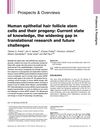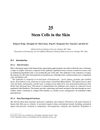TLDR TACE/ADAM17 is essential for maintaining healthy hair and hair follicle stem cells.
The study investigated the role of TACE/ADAM17 in hair follicle (HF) stem cell niche establishment using a mouse model with conditional depletion of TACE in SOX9-expressing cells. Mice lacking TACE (Tace/Sox9) exhibited brittle hair, prolonged anagen phase, and progressive hair loss, culminating in complete hair loss by 20 weeks. These mice showed a lack of CD34(+) bulge cells, downregulation of key transcription factors (Sox9, Lhx2, Gata3), and upregulation of Lef1, indicating a failure to establish the bulge niche and maintain HF stem cell "stemness." Additionally, impaired EGFR signaling in Tace/Sox9 keratinocytes suggested that EGFR is a downstream pathway of TACE in HF homeostasis. The findings provided insights into the mechanistic implications of TACE deficiency and hair abnormalities associated with EGFR inhibitors.
36 citations
,
April 2010 in “The journal of investigative dermatology/Journal of investigative dermatology” Canine hair follicles have stem cells similar to human hair follicles, useful for studying hair disorders.
39 citations
,
March 2009 in “Dermatology Online Journal” Erlotinib can cause persistent excessive hair growth.
1279 citations
,
November 2005 in “Nature Medicine” 561 citations
,
April 2003 in “Journal of Investigative Dermatology” CD34 is a marker for isolating stem-like cells in mouse hair follicles.
555 citations
,
July 2001 in “Genes & Development” Tcf3 and Lef1 are key in deciding skin stem cell roles.
107 citations
,
June 1997 in “PubMed” EGFR is essential for normal hair development and follicle differentiation.
 106 citations
,
March 2014 in “BioEssays”
106 citations
,
March 2014 in “BioEssays” We need more research to better understand human hair follicle stem cells for improved treatments for hair loss and skin cancer.
9 citations
,
June 2016 in “Stem cells” Overexpression of sPLA2-IIA in mouse skin reduces hair stem cells and increases cell differentiation through JNK/c-Jun pathway activation.
286 citations
,
June 2012 in “Nature Immunology” Hair follicles help attract immune cells to the skin during stress.

Skin stem cells are crucial for maintaining and repairing skin, with potential for treating skin disorders and improving wound healing.
13 citations
,
April 2019 in “iScience” EGFR helps control how hair grows and forms without needing p53 protein.

